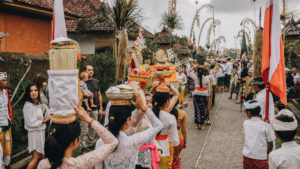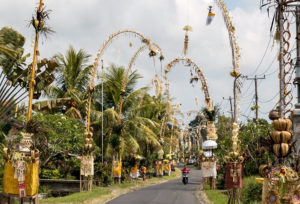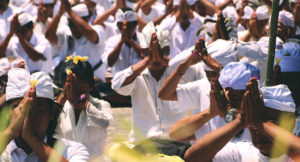Bali is renowned for its bright and richly cultural ceremonies, and any visitor who spends more than a few days on the island will be certain to see some kind of Hindu temple festival, colourful procession, or ritual. If you’re fortunate enough to be in Bali this year between 2nd and 12th August, you will see the streets lined with slender, eight-metre-high, gracefully arching bamboo poles, festooned with flowers, fruit, unhusked rice and palm frond ornamentation. Known as ‘penjor’, these gorgeous all-natural decorations are displayed in celebration of ‘Galungan’, the island’s most important religious festival, which occurs every 210 days, always on a Wednesday, in accordance with the Balinese calendar.

This holiday celebrates the creation of the universe and the victory of good over evil so that the balance and harmony of the world can be maintained. This is when the ancestral spirits and Balinese Hindu deities descend to Earth to be honoured; it is a time of fun, family reunions, ritual feasting, prayers and offerings. Most Galungan celebrations take place in the privacy of the home, at the shrines of the family temple and in the house compound, so Galungan is often referred to as the Balinese equivalent of Christmas.

Preparations for the ten-day festival will begin several days in advance when each Balinese family will create and place a penjor outside their gate, which makes the whole neighbourhood come to life. The Balinese believe that the penjor symbolises the mountain, and the mountain itself is the symbol of the universe. Therefore, the penjor is synonymous with Mount Agung, Bali’s tallest, most sacred mountain. The aim of placing penjors at Galungan is to show devotion to God in his manifestation as the God of the Mountain (Hyang Giri Pati). Rainwater flows from the mountains into Bali’s four freshwater volcanic crater lakes, which in turn shed their life-giving water into fertile plains through deep, narrow and excessively steep river gorges and plummeting falls, fulfilling the needs for irrigation and drinking water. This festive time probably has its origins in an ancient pre-Hindu harvest festival and it is still forbidden to begin planting crops during this period.
Much work also goes into the making of lawar, a spicy hash of raw meat, grated coconut, vegetables and pig’s blood, traditionally prepared at the roadside by the men of each village. This year, Wednesday 2nd August marks the first day of Galungan, and you will see people dressed in their finest clothes bearing elaborate offerings to their temple of origin. The day after Galungan is called ‘Manis Galungan’, this is the day that the Balinese dedicate to visiting relatives and spending time with their families.

Ten days later, on Kuningan, the final day of the festival, which is always a Saturday, the Balinese will make farewell offerings for the ancestors. This includes yellow rice (Kuningan is derived from the word ‘kuning’ meaning yellow), which is placed in a small coconut leaf bowl. The yellow rice is a symbol of gratitude to God for nature’s abundance, life, joy, wealth, health and prosperity. At the island’s holy springs, the devout Balinese Hindus will bathe to purify themselves and bear witness to their newly acquired state of grace via a ‘wijen’ blessing of rice kernels stuck to their foreheads. Hundreds of local people wearing colourful ceremonial dress – the women carrying towering ‘pajegan’ pyramids of decorative fruit and flower offerings on their heads – can be seen in solemn procession to the temples as they pay homage to the gods. The celebration usually takes place before noon, and in some villages, you will see the ‘barong’ or ‘ngelawang’ – a lion like creature, with bulging eyes and a long black beard garnished with flowers. He is propelled by two men (a bit like a pantomime horse) sporting a fabulous costume, composed of a bamboo frame draped with pandanus leaf fibre, feathers, bells, glass and mirrors. He is mischievous and fun-loving, representing everything that is good. The barong will go from house to house followed by kids playing loud gongs and drums. The custom is to give the barong an offering of some money after which he will dance and bless the house and family. Often at Kuningan, the barong is propelled by two young boys, and sometimes they will come into cafes and restaurants.
The day after Kuningan is a family day when the playing fields, markets and beaches are filled with people. Kuningan also marks the end of the 210-day Balinese Pawukon calendar, which was brought to Bali in the 14th century by the fleeing Hindu Majapahits of Java.
If you are in Bali at this special time, you can witness the splendid traditions of the Balinese culture firsthand. Be aware that there could be road closures due to ceremonial processions, and many Balinese-owned businesses will be closed as well. Visitors are asked to be respectful and exercise patience and appreciation because these ceremonies and celebrations are sacred to the Balinese and are a major part of what makes the culture so beautiful and welcoming to visitors.
